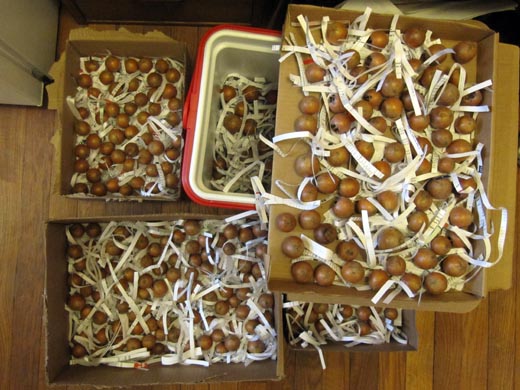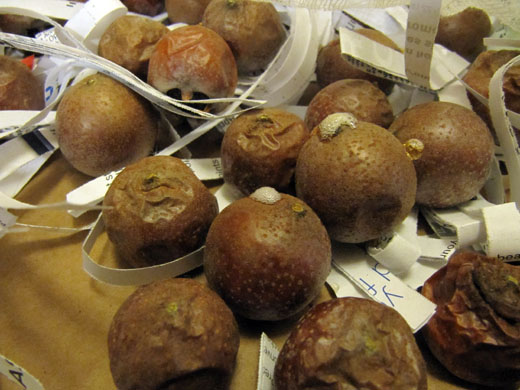 Christmas songs are quick to commemorate the sounds and the sights of the season, but rarely do they dwell on smells. Most people, I gather, fondly recall the fragrance of spruce needles or the cloying whiff of cookies, but this year I’ll pine for a more medieval Christmas scent: the sweet, pseudo-oenomelic aroma of tiny, rotting fruit.
Christmas songs are quick to commemorate the sounds and the sights of the season, but rarely do they dwell on smells. Most people, I gather, fondly recall the fragrance of spruce needles or the cloying whiff of cookies, but this year I’ll pine for a more medieval Christmas scent: the sweet, pseudo-oenomelic aroma of tiny, rotting fruit.
Meet the National Cathedral medlar! Planted in 1962 to honor Florence Bratenahl, the medievalist who refined Frederick Law Olmsted’s plan for the cathedral garden, the tree goes unnoticed by nearly everyone. There aren’t many medlars in America, and when the cathedral horticultural staff and garden guild kindly let me harvest the fruit of their medlar in December 2010 (in exchange for writing two articles for the garden guild newsletter), I soon learned why: this is one persnickety tree.

Every spring, the medlar’s large white flowers blossom with absurd brevity, at a day and hour determined by the tree’s own inscrutable whim. (Most years, the medlar stubbornly hangs onto its red-gold leaves well into December, long after other trees are as bony and cold as Dickensian waifs.) During the summer, the flowers turn into grotty little fruit with deservedly obscene medieval nicknames. The French knew the medlar as the cul de chien, and Chaucer called it the “open-arse”; his bitter Reeve likened himself to a medlar in The Canterbury Tales. More recently, Shakespeare denigrated the medlar in four different plays, and D.H. Lawrence, not one to be outdone, dubbed them “wineskins of brown morbidity” and “the distilled essence of hell.”
You see, here’s the thing about medlars: The fruit is hard, acidic, and inedible until a good early-winter cold snap, after which it has to “blett,” or ripen into the semblance of rottenness, under precise conditions known only to God and the medlar itself. (Some sources even warn you not to jostle the fruit or let them touch each other. Medlars are the Happy Fun Ball of obsolete produce.)
Medieval people would have bletted their medlars in wooden crates filled with straw. As a modern-day apartment dweller, I bletted ten pounds of medlar fruit in cardboard boxes lined with shredded credit-card courtesy checks.

Bletting medlars is a lost art. Hours turn into days, days turn into weeks, acids turn into sugars, and the end result is…most inelegant.

Did I mention they sometimes sigh or whistle when squeezed?
Ah, but holy crow, the smell of a home full of bletting medlars is truly divine. They smell like they taste: a robust blend of applesauce, cinnamon, and cheap wine. Charlemagne ordered the medlar to be grown on royal estates; a barn or fruit cellar full of bletting medlars must have been heaven for the Carolingian nose.
Participating in one medlar harvest made clear to me why this fruit, well known to medieval people, is barely a novelty now. For one thing, despite my best efforts at climate control, at least two pounds of fruit took the express lane straight past “bletted” and into genuine rot. Also, once you get past the five gigantic seeds in each fruit, you’ve not much of the squishy stuff to eat. In the U.K., Tiptree sells a lovely medlar jelly, but when a dear friend and I decided to try a medlar tart recipe from an Elizabethan cookbook, we spent hours mutilating hundreds (hundreds!) of weeping squishballs to make just two of these:

That tart’s tastiness was inversely proportional to its beauty, but it was also ludicrously labor-intensive. Medieval and early modern Europeans ate the fruit straight-up or enjoyed mashed and boiled jellies; a tart was a rare luxury.
As medlars lack widespread commercial value—did I mention concerns about their “violent laxative properties”?—the wizards of modern food science haven’t bothered to demystify them. For the latest medlarology, you have to dig up a 1989 Economic Botany article that documents (with remarkable encyclopedicity) everything now known about them, from passing references in classical texts to the chemical composition of the wood. Still, even in our Internet age, no one can tell you exactly how to blett the fruit, and I’m currently preparing to answer a barrage of riddles in a crumbling, booby-trapped crypt so a thousand-year-old crusader will pass on to me the mystic secret of cultivating medlars from seeds.
I hit the wrinkly rare-fruit jackpot in 2010. Since then, the medlar tree at the National Cathedral has (the chief horticulturalist tells me) suffered from fire blight, which is common among trees in the apple family. The fruit blackens and dies before maturing; a cool, wet spring may cause the problem to recur. (Lacking the ability to do anything useful, I’ve worked several medlar references into the poems in Looking Up.)
The truth is, if the medlar sprouted elf heads or started singing madrigals, it couldn’t befuddle me more than it already has, but I’ll never forget the aroma that welcomed me home every time I returned from some tedious holiday errand. The National Cathedral medlar reminds me that the road back to the Middle Ages is not only endless, but also endlessly strange. Relieved to know I’ll never run out of things to write about, I can only wish the readers of this blog a blessedly olfactive Christmas—and a New Year as hopeful and sweet as a medlar-blessed home.


Hurricane Sandy laid waste most of our beautiful wooded yard. It was a minor miracle that it it left our two spindly medlar trees untouched. Its wind did remove all of their leaves and the two fruits that were being protected from a herd of deer that were eying them since late summer.
An effort was made to grow trees from seeds that were donated to the cause by Jeff. They were placed in a freezer for months and then planted in pots. After a few months I decided to check under the earth in the pots to see if there were any sign of life. Not only was there no sign of life, there were no signs of the seeds ever being planted. The mystery of growing them from seed deepens.
LikeLike
This posts makes me absurdly happy. I’ve always wondered about medlars (well, not so much that I ever did more than furrow my brow over a few unilluminating footnotes, but furrow I have).
Thanks!
LikeLike
Medieval and early modern Europeans ate the fruit straight-up or enjoyed mashed and boiled jellies; a tart was a rare luxury.
Based on your description, I can see why, especially if one uses fruits like medlars. But berry tarts are (relatively) easy.
Also, what base did you use for your medlar tart?
LikeLike
Flavia: Thanks! A comment like that is an early Christmas present.
Jake: Yeah, tarts are easy to make, but I specifically meant medlars there; getting enough useable goo out of them is an atypically exhausting enterprise. (If I remember correctly, we used only eggs, a bit of sugar, and a dash of cinnamon. We opted, also, for an edible shell made from wheat flour.)
LikeLike
Sublime! Though I’ve never experienced any “violent laxative properties” or other untoward character. Your modern straw of “shredded credit-card courtesy checks” was both creative and rather confetti-ish, giving the medlars a nice visual contrast. As to those tarts, such a work of love or act of madness. It looks scrumptious, demanding slow eating. A thoroughly delicious post. Thank you for all the trouble it took.
LikeLike
Jeff, this is very interesting. Thanks for sharing and best Christmas and New Year’s wishes.
LikeLike
Jeff, this inspires me to root around for my medieval cookbook… Loved reading your medlar post, as there are so many references to medlars in literature.
Do you think so many medlars rotted because of the warmth of a modern life? Wouldn’t a medieval cook pop them into a hole in the ground, maybe with some cushioning bark? Some sort of cold cellar?
My mother canned four little jars of damson plums last year, and I managed to get several. They remind me of medlars–rare, astringent and sour, lovely when cooked. Also, both medlars and damsons are made into so-called fruit cheese. Maybe you should try that traditional mode next time!
LikeLike
Oh gosh and you do medlars too! And there’s Anna Tambour who I met through medlars. Here are a couple of posts from my period of medlar mania
http://box-elder.blogspot.fr/2011/12/medlar-update.html
http://box-elder.blogspot.fr/2011/11/meddling-with-medlarsand-al-was-for.html
LikeLike